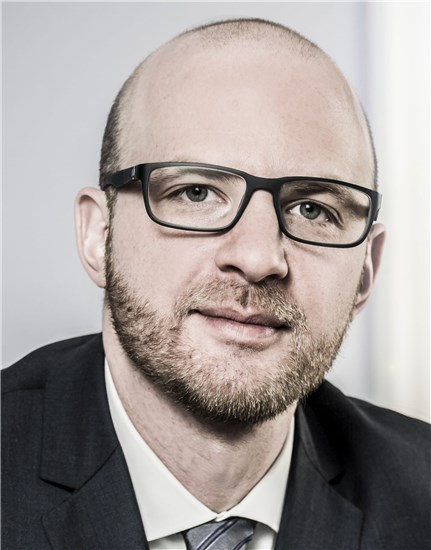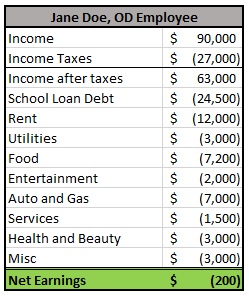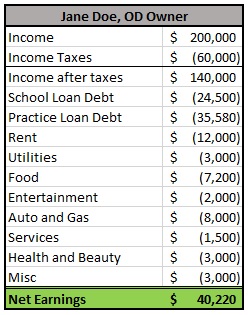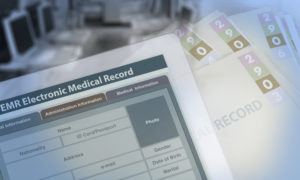By Erik Ferjentsik, MBA

August 5, 2015
Congratulations, Jane Doe, OD, you’re a recent optometry school grad and vibrant young budding optometrist! In no time, you’ll be driving a brand new Mercedes-Benz convertible and pondering which country club to join, right? Not quite. These days, you’re more likely to be adding another 200,000 miles to the same beat-up sedan you’ve had since you were an undergrad, and eating not-so-exquisite ramen noodle dinners just to make ends meet.
Student Loan Debt: What’s Typical?
According to a recent survey by Optometrydebt.com, the median optometrist student loan debt for 2014 was $197,281. The highest debt for a 2014 graduate was $250,000 and the lowest was $90,000.
If you also add remaining undergraduate school loan debt to the picture, many young grads are staring blankly at a Sallie Mae statement that surpasses $200,000, like poor Dr. Doe, who carries $230,000 in total school loan debt with an average interest rate of 6.8 percent. —Erik Ferjentsik, MBA
Paying off a massive student loan, covering a mortgage or rent, and additional living expenses, including utilities and groceries, can leave a new optometrist unexpectedly living paycheck to paycheck.
The good news is there are financial strategies that can help you manage your debt and pay it off faster. First, however, you must understand your most profitable path–most often it is to be a practice owner or partner, rather than an employed OD–and then determine a strategy to get there.
The average starting salary for an optometrist varies by location, but can be estimated at around $80,000. The American Optometric Association Research and Information Center determined optometrists who have graduated from optometry school within the last 10 years earn a net income at just under $95,000. After taxes and school loan debt, there’s little meat left on the bone.
Let’s continue using Dr. Jane Doe as an example. Using a standard loan calculator for her $230,000 in school loan debt at a fixed average interest rate of 6.8 percent for 15 years, she would have monthly payments of $2,042 per month, or $24,500 per year. That payment adds up to approximately one-quarter of a new optometrist’s take-home pay every month. In many cases, it might be advisable to apply for an extended repayment or Income Based Repayment plan and adjust the term up 30 years, which would increase overall interest paid, but could reduce the monthly payment burden significantly. In this case, we’ll stick with 15 years.
Calculate Earning & Debt Payoff Time as Employed OD
Below, in the chart, “Jane Doe, OD Employee, is a snapshot of Dr. Doe’s net earnings as a young optometrist based on common cost of livings values for young optometrists:
 This example does not account for any major surprises like a massive car repair, major uncovered medical issue, or any other unexpected expenses. Nor does it include a vacation, family expenses or investment in retirement.
This example does not account for any major surprises like a massive car repair, major uncovered medical issue, or any other unexpected expenses. Nor does it include a vacation, family expenses or investment in retirement.
Eye doctors have long been considered a prominent class of American professionals. So, how does our dear friend Dr. Doe earn enough dough to live comfortably?
The best option is to move toward practice ownership.OD owners/partnersearn an average of $143,317 vs. $107,712 for employed ODs, according to the 2015 ECP Compensation Study from Jobson Optical Research. Our clients at Visionary Practice Group (VPG), typically earn at least $180,000 to $200,000 for a single-OD, single-location practice. We’ve also worked with go-getters who grow from a single-location private practice to a multi-location / multi-doctor practice model. Those who do so can earn over $1,000,000 in income and work less than full-time hours in many cases.
Calculate Earnings & Payoff Time as Practice Owner
Now, let’s take a look at Dr. Doe’s net earnings in her first year as a single-location, single-OD private practice owner, all other expenses constant:
 You will see in the chart to the left, “Jane Doe, OD Owner, that even with a practice purchase loan of about $35,000 per year, Jane is still making much more money. And remember much of that $35,000 goes toward her equity in the practice, which she will get to sell when she’s ready to retire or bring in a partner. After 10-15 years, after the loan is paid off, Jane’s net earnings would jump to about $75,000, which doesn’t account for any growth or improvements she might be able to implement! It’s a simplified example to make the point clear that the only way to open the door to increased earnings is through practice ownership.
You will see in the chart to the left, “Jane Doe, OD Owner, that even with a practice purchase loan of about $35,000 per year, Jane is still making much more money. And remember much of that $35,000 goes toward her equity in the practice, which she will get to sell when she’s ready to retire or bring in a partner. After 10-15 years, after the loan is paid off, Jane’s net earnings would jump to about $75,000, which doesn’t account for any growth or improvements she might be able to implement! It’s a simplified example to make the point clear that the only way to open the door to increased earnings is through practice ownership.
Dr. Doe is actually modeled after a client I worked with in the recent past. She is a real-life OD who I recently helped buy a practice. At her former place of employment, she was seeing 28-32 patients per day with 20 refractions per day on average. That’s very high volume.
At one point, she asked me if practice ownership was worth the effort. So, I showed her a few quick calculations. The average revenue she brought the practice per refraction was about $300.
Twenty-eight to 32 patients per day is super-high when compared to national averages. But it’s not all that uncommon for employee ODs working at chains or larger group practices. I was contacted recently by an OD seeing over 30 patients a day, which was his reason for calling. He was seeking ownership options to get out of such a high volume “sweatshop,” inhis exact words.
The math for Dr. Doe: 20 refractions per day x $306 average revenue per refraction x 5 days per week x 49 weeks per year = $1,499,400. (assuming 2 weeks vacation and 1 week holiday). Again, this doesn’t include the revenue generated from the other 8-12 patients per day. It means she’s actually refracting 4,900 patients per year!
Based on the volume of patients she was seeing, she was generating almost $1,500,000 in revenue for the practice on refraction patients alone. That’s an estimated $415,000 in net income for the practice. Her salary was about $120,000 including benefit value. So, essentially, for the same effort she could more than triple her income if she was working for herself. After hearing that, she agreed that pursuing a practice purchase was the best option for her, knowing that she could continue working while Visionary Practice Group handled most of the purchase process. She still had to apply for insurance credentialing and fill out some financing applications, among other things, but she will attest to this day that the ends justified the means.
So, how do you become a practice owner? It’s not as hard as it may seem. You search for practices for sale, partnership opportunities and start-up opportunities. You can simply do this on the web. I urge you to contact a practice brokerage and start-up consulting firm like Visionary Practice Group. We will provide free guidance and help you determine the best path to ownership. We will also enter you into our database, so any time a practice opportunity meeting your requirements pops up on our radar, you will be the first to know.
Buy or Start Your Own Practice?
Buy
Buying is the least risky, because there is an existing patient base and history of proven results. Similar to real estate, you have the right to, and should be represented, by a competent practice broker/consultant throughout the entire practice purchase transaction. Starting a practice, on the other hand, is more risky and time consuming, but the growth opportunities can be much greater and more rewarding. If starting a practice, it is imperative to hire an industry-specialized consultant. Doing so will allow you to continue to work full or part-time, and will save you time, money and mistakes in the long-run.
I know what you’re thinking: “How can I afford to buy or start a practice with so much school loan debt?”
Firms like mine are able to connect you with specialized lending divisions of major commercial banks, which we work with regularly.
Purchase
If you’re seeking a practice purchase opportunity, I recommend only dealing with sellers who are working with a qualified optometric practice broker, and who have had the practice appraised. It shows they are serious about selling. The appraisal should justify the asking price. In some cases it doesn’t, or the practice value can be overstated. You are entitled to get a second-opinion appraisal, which your practice broker/consultant may offer at a discount assuming the practice seller has all the financial data and material needed for your appraiser to complete the valuation. Mainly, you and your broker want to fully explore all opportunities that fit your needs and goals and ensure that each practice seller you come across is truly ready to transition out of the practice at a reasonable price and terms.
Whether you pursue a practice purchase, start-up or partnership, it will undoubtedly be the most important and influential decision of your professional life. It’s vital to ensure you have the right team behind you to protect your best interests. If you do, the decision to become a practice owner should lead to a long future of financial success and professional freedom.
Dr. Jane Doe was an extremely apprehensive practice purchaser. She didn’t have confidence about her knowledge of business or her ability to run a practice. With our help, I’m happy to report that she is now making almost 2.5x her previous income and seeing about half the patients per day she saw at her previous place of employment. Her new practice allows her the time to give better and more personalized treatment to her patients and have a work/life balance that is sustainable for her and her family. All things considered, we can now refer to her as Dr. Jane ‘Dough,’ because she’s no longer struggling to cover her bills as a low-income optometrist, and instead, she’s a practice owner bringing in the dough!
Erik Ferjentsik, MBA, is President and Principal Consultant of Visionary Practice Group, LLC, an optometric consulting and brokerage firm consisting of attorneys, MBAs, CPAs, and OD practice owners and management experts specializing in providing practice appraisals, brokerage, and consulting services for optometrists to bring ODs the most successful results in practice sales, purchases, partnerships and transitions. To contact: (877) 268-8881 or erikf@visionarypracticegroup.com.

























